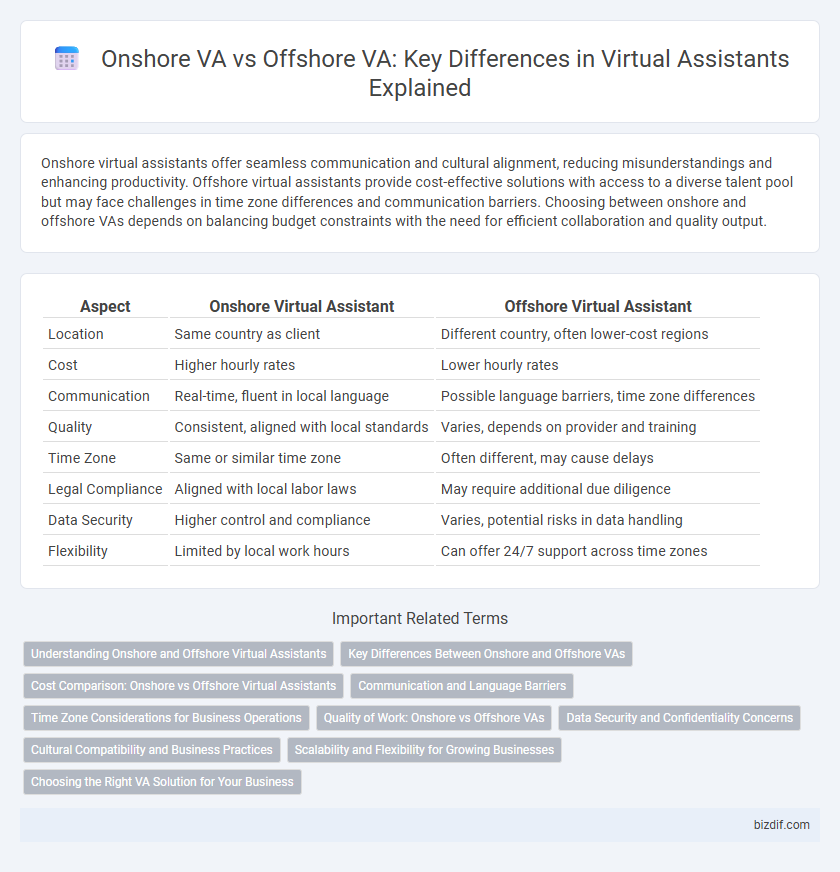Onshore virtual assistants offer seamless communication and cultural alignment, reducing misunderstandings and enhancing productivity. Offshore virtual assistants provide cost-effective solutions with access to a diverse talent pool but may face challenges in time zone differences and communication barriers. Choosing between onshore and offshore VAs depends on balancing budget constraints with the need for efficient collaboration and quality output.
Table of Comparison
| Aspect | Onshore Virtual Assistant | Offshore Virtual Assistant |
|---|---|---|
| Location | Same country as client | Different country, often lower-cost regions |
| Cost | Higher hourly rates | Lower hourly rates |
| Communication | Real-time, fluent in local language | Possible language barriers, time zone differences |
| Quality | Consistent, aligned with local standards | Varies, depends on provider and training |
| Time Zone | Same or similar time zone | Often different, may cause delays |
| Legal Compliance | Aligned with local labor laws | May require additional due diligence |
| Data Security | Higher control and compliance | Varies, potential risks in data handling |
| Flexibility | Limited by local work hours | Can offer 24/7 support across time zones |
Understanding Onshore and Offshore Virtual Assistants
Onshore virtual assistants (VAs) are based in the same country as their clients, offering cultural alignment, real-time communication, and easier coordination due to shared time zones. Offshore virtual assistants operate from different countries, often providing cost-effective solutions while potentially facing challenges like language barriers and time zone differences. Choosing between onshore and offshore VAs depends on priorities such as budget, communication preferences, and the need for cultural compatibility.
Key Differences Between Onshore and Offshore VAs
Onshore virtual assistants provide localized support with cultural alignment, superior language proficiency, and easier communication due to shared time zones, enhancing real-time collaboration. Offshore virtual assistants offer cost-effective services, access to a diverse talent pool, and flexibility across multiple time zones, but may face challenges like language barriers and differing work standards. Key differences between onshore and offshore VAs revolve around cost, communication quality, and cultural compatibility impacting project efficiency and output quality.
Cost Comparison: Onshore vs Offshore Virtual Assistants
Onshore virtual assistants typically charge higher hourly rates, ranging from $25 to $50, due to local labor costs and regulatory standards. Offshore virtual assistants offer more affordable options, with rates often between $8 and $20 per hour, influenced by lower living expenses in countries like the Philippines and India. Cost differences impact overall budget allocation, making offshore VAs a preferred choice for businesses seeking to reduce operational expenses while maintaining productivity.
Communication and Language Barriers
Onshore virtual assistants typically offer seamless communication due to shared language fluency and cultural understanding, reducing misunderstandings and enhancing collaboration efficiency. Offshore virtual assistants may present language barriers and time zone differences that can complicate real-time communication and delay project delivery. Choosing between onshore and offshore VAs depends on prioritizing immediate, clear communication or cost-effective service with potential language challenges.
Time Zone Considerations for Business Operations
Onshore virtual assistants operate within the same or closely aligned time zones as the business, ensuring real-time communication and immediate response to urgent tasks. Offshore virtual assistants may present challenges with time zone differences, potentially delaying project timelines and reducing overlap during critical working hours. Businesses prioritizing seamless collaboration and quick turnaround times often prefer onshore VAs to optimize operational efficiency and maintain consistent workflow.
Quality of Work: Onshore vs Offshore VAs
Onshore virtual assistants typically deliver higher quality of work due to closer cultural alignment, better language proficiency, and easier communication, which minimizes errors and enhances collaboration. Offshore VAs may offer cost savings but face challenges such as time zone differences, language barriers, and varied work standards that can impact the precision and reliability of tasks. Businesses prioritizing quality and seamless integration often prefer onshore VAs to maintain consistent performance and client satisfaction.
Data Security and Confidentiality Concerns
Onshore virtual assistants offer enhanced data security and confidentiality due to closer regulatory oversight and adherence to local data protection laws such as GDPR and CCPA. Offshore virtual assistants may present risks related to differing legal frameworks and potential vulnerabilities in cross-border data transmission. Businesses prioritizing sensitive information often prefer onshore VAs to mitigate exposure to data breaches and ensure stringent compliance with privacy standards.
Cultural Compatibility and Business Practices
Onshore virtual assistants offer higher cultural compatibility by sharing language nuances, work ethics, and familiar business practices with local clients, leading to smoother communication and fewer misunderstandings. Offshore virtual assistants may present challenges in aligning work hours, communication styles, and business expectations due to cultural differences, which can impact project efficiency. Selecting an onshore VA can enhance collaboration and ensure that business practices align closely with company standards and local market demands.
Scalability and Flexibility for Growing Businesses
Onshore VAs typically offer greater scalability and flexibility for growing businesses due to aligned time zones and cultural understanding, enabling seamless communication and quick adaptation. Offshore VAs provide cost-effective scalability but may face challenges in flexibility because of time zone differences and potential communication barriers. Choosing between onshore and offshore VAs depends on the specific needs for responsiveness and budget constraints in a growing business.
Choosing the Right VA Solution for Your Business
Choosing the right virtual assistant (VA) solution depends on your business needs, budget, and communication preferences. Onshore VAs offer easier collaboration, cultural alignment, and faster response times, making them ideal for tasks requiring high-security and close oversight. Offshore VAs provide cost-effective support with access to a broader talent pool, suitable for businesses prioritizing affordability and scalability without compromising quality.
Onshore VA vs Offshore VA Infographic

 bizdif.com
bizdif.com